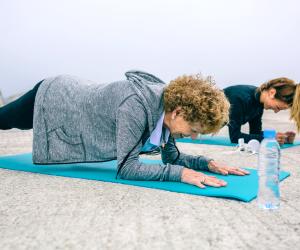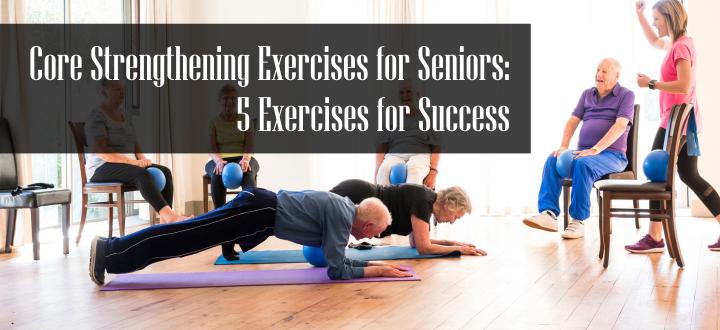As we age, maintaining good health and independence becomes increasingly important. One key component of a healthy lifestyle is core strength – which can help prevent falls, reduce back pain, and improve overall balance and stability.
In this article, we’ll explore the benefits of core strengthening exercises for seniors and provide an overview of the best exercises to help improve core strength in people of this age group.
Whether you’re a senior looking to stay active and healthy – or a caregiver helping a loved one, this article will provide valuable information on how to maintain and improve your core strength through safe and effective exercises.
Contents
- 1 The Different Types of Core Muscles
- 2 5 Effective Core Strengthening Exercises for Seniors
- 3 Modifications to Accommodate Seniors with Physical Limitations
- 4 Precautions to Take When Doing Core Strengthening Exercises
- 5 Beginners Core Strengthening Workout for Seniors
- 6 Frequently Asked Questions (FAQ)
- 7 Final Words
- 8 Other Helpful Resources
The Different Types of Core Muscles
Before diving into specific exercises, it’s essential to understand the muscles that make up the core region. The core muscles include:
- Rectus Abdominis: Located in the front of the abdomen, this muscle is responsible for flexing the trunk and bending forward.
- Transverse Abdominis: The deepest of the abdominal muscles, this muscle helps stabilize the spine and pelvis.
- External Obliques: Located on either side of the rectus abdominis, these muscles are responsible for rotating the trunk and bending sideways.
- Internal Obliques: Located beneath the external obliques, the internal oblique muscles work with the external obliques to rotate the trunk and bend sideways.
- Erector Spinae: Located along the spine, these muscles help maintain an upright posture and extend the spine.
- Multifidus: These small muscles run along the spine and help stabilize the spine during movement.
- Gluteus Maximus: The largest muscle in the body, the gluteus Maximus, helps extend the hip joint and maintain an upright posture.
Together, these muscles work to stabilize the spine and pelvis, maintain good posture, and support movement in the hips and trunk.
By strengthening these muscles through targeted exercises, seniors can improve their overall physical function and reduce their risk of falls and injuries.
5 Effective Core Strengthening Exercises for Seniors
The exercises we will look into can be performed both on the floor and while standing and can be modified to accommodate a wide range of fitness levels and physical abilities. The following exercises are particularly effective for seniors looking to improve their core strength:
- Plank
- Bird Dog
- Glute Bridge
- Seated Knee Lifts
- Standing Twist
Let’s take a closer look at each of them:
Plank

Begin in a push-up position with your hands shoulder-width apart and your feet hip-width apart. Lower your forearms to the ground, keeping your elbows directly under your shoulders. Hold this position for 20-30 seconds, keeping your back straight and your core engaged. Feel the burn throughout your abdominal muscles.
Bird Dog
Begin on your hands and knees with your hands shoulder-width apart and your knees hip-width apart. Lift your right arm and left leg straight out in front of you, holding for a few seconds before returning to the starting position. Repeat with the opposite arm and leg.
Glute Bridge
Lie on your back with your knees bent and feet flat on the ground. Lift your hips off the ground, squeezing your glutes and engaging your core. Hold for a few seconds before lowering back down to the ground.
Seated Knee Lifts
Sit on a chair with your back straight and your feet flat on the ground. This will be your starting position. Lift your right knee towards your chest, holding for a few seconds before lowering back down. Repeat with the left knee.
Standing Twist
Stand with your feet shoulder-width apart and your arms extended in front of you. Twist your torso to the right, bringing your left elbow towards your right knee. Return to the starting position before repeating on the other side.
Modifications to Accommodate Seniors with Physical Limitations
For seniors with physical limitations, modifying exercises to ensure safety and prevent the risk of injury is crucial. Some modifications for the above-described exercises may include:
Plank
Perform the exercise with your knees on the ground instead of in a full push-up position.
Bird Dog
Perform the exercise while seated in a chair instead of on the ground.
Glute Bridge
Perform the exercise with your feet flat on the ground instead of lifting your hips.
Seated Knee Lifts
Perform the exercise with one leg at a time instead of alternating between legs.
Standing Twist
Perform the exercise with a smaller range of motion and a slower pace to reduce strain on the back.
By incorporating these core strengthening exercises into a regular fitness routine and making them part of their daily activities, seniors can improve their core strength, reduce their risk of falls – and enjoy a better quality of life.
Precautions to Take When Doing Core Strengthening Exercises
While core strengthening exercises can be beneficial for seniors, it’s important to take certain precautions to avoid injury and ensure safety during exercise.
Common Mistakes – and How to Avoid Them
One common mistake seniors make when doing core strengthening exercises is holding their breath, which can increase blood pressure and cause dizziness. To avoid this, focus on breathing slowly and deeply throughout the exercise.
Another mistake is overexerting, which can lead to injury. Instead, seniors need to start with low-intensity exercises and gradually increase as they become stronger and more comfortable with the movements.
Warning Signs to Look Out for During Exercise
Seniors should be aware of certain signs that may indicate they need to stop or modify their exercise routine. These signs include:
- Chest pain or discomfort
- Shortness of breath
- Dizziness or lightheadedness
- Nausea or vomiting
- Extreme fatigue or weakness
If seniors experience any of these symptoms during exercise, they should stop immediately and rest until the symptoms subside. If symptoms persist or worsen, they should seek medical attention.
When to Seek Medical Attention

While core strengthening exercises can be beneficial, they may not be appropriate for everyone. Seniors with certain medical conditions, such as osteoporosis or herniated discs, should consult with their healthcare provider before starting an exercise routine.
Additionally, seniors should seek medical attention if they experience any of the following:
- New or persistent joint pain
- Pain that does not go away with rest
- Swelling or redness in the joints
- Limited range of motion
- Difficulty performing activities of daily living
By taking these precautions and seeking medical attention when necessary, seniors can safely and effectively improve their core strength and enjoy the many benefits of exercise.
Beginners Core Strengthening Workout for Seniors
Warm-up:
- 5-10 minutes of light cardiovascular exercise (e.g. walking or marching in place)
Main workout:
- Plank – hold for 20-30 seconds
- Bird Dog – 8-10 reps on each side
- Glute Bridge – 10-12 reps
- Seated Knee Lifts – 10-12 reps on each side
- Standing Twist – 8-10 reps on each side
Repeat the entire circuit 2-3 times, resting for 30-60 seconds between each circuit.
Cool-down:
- 5-10 minutes of stretching exercises (e.g. gentle forward folds or seated twists)
Remember, it’s essential to start with low-intensity exercises and gradually increase as you become stronger and more comfortable with the movements. Also, focus on breathing slowly and deeply throughout the exercise, and be aware of signs indicating you need to stop or modify the routine.
Frequently Asked Questions (FAQ)
There are several core exercises that are beneficial for seniors, but the best ones are those that are safe and effective. Some of the best core exercises for seniors include the plank, bird dog, glute bridge, seated knee lifts, and standing twists. These exercises can help improve balance, stability, and posture while reducing the risk of chronic conditions like osteoporosis and back pain.
Older people can strengthen their core through various exercises, including planks, sit-ups, bridges, and twists. It’s essential to start with low-intensity exercises and gradually increase as they become stronger and more comfortable with the movements. Seniors should also focus on breathing slowly and deeply throughout the exercise and be aware of signs that may indicate they need to stop or modify their routine.
While walking is a great exercise and can provide cardiovascular benefits, it is not a specific core-strengthening exercise. However, walking with good posture and engaging the core muscles can help improve overall balance and stability, indirectly strengthening the core.
Read more: Does Walking Strengthen Your Core? 3 Hacks to Build Core Strength While Walking
The symptoms of a weak core can vary, but some common signs include poor posture, lower back pain, limited mobility, and difficulty with balance or stability. A weak core can also lead to difficulty with activities of daily living, like bending, lifting, and reaching.
A weak core can lead to several long-term health issues, including chronic lower back pain, poor posture, and reduced mobility. A weak core can also increase the risk of falls, which can lead to serious injuries in seniors.
While exercise is the most effective way to strengthen the core, a few everyday activities can also help, such as standing up straight with good posture, carrying groceries evenly in both hands and engaging the core muscles while doing everyday activities like sitting and walking. However, it’s important to note that these activities may not provide the same level of strength and conditioning as specific core strengthening exercises.
Final Words
Core strengthening exercises can help seniors maintain their independence and improve their overall health and well-being. A strong core can also help prevent falls and injuries common among older adults.
By incorporating exercises like the plank, bird dog, glute bridge, seated knee lifts, and standing twist into their exercise routine, seniors can improve their balance, stability, and posture – as well as reduce their risk of chronic conditions like osteoporosis and back pain.
However, seniors need to take certain precautions, like breathing deeply and gradually increasing intensity, to ensure safety during exercise. Seniors should also be aware of signs indicating they need to stop or modify their exercise routine and should seek medical attention if necessary.
Overall, by incorporating core strengthening exercises into their routine and taking necessary precautions, seniors can improve their physical health and maintain their independence for years to come.
If you want to learn about balance and core exercises for seniors with back pain or simply want to read more about strength training, visit my MASSIVE home workouts archive for tons of actionable hacks and tips.
See you there!


